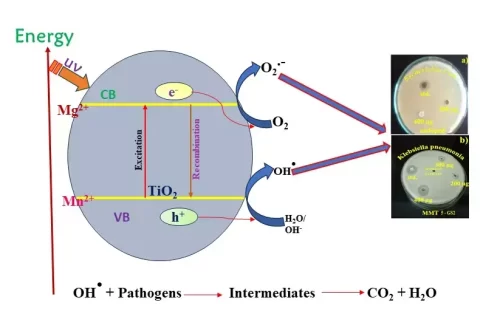Synthesis, Characterization, and Antibacterial Properties of Surfactant Encapsulated Mn/Mg Co-doped Titania Nanoparticles
Authors
Abstract
The current research work was mainly focused on the antibacterial performance of Mn/Mg co-doped TiO2 nanoparticles in presence of Gemini surfactant (GS). Mn, Mg co-doped TiO2 nanoparticles were synthesized by sol-gel method and calcined at 450 0C. The characterization results reveal that among all the co-doped TiO2 and surfactant encapsulated TiO2 nanoparticles, the MMT5-GS2 Nano catalyst exhibited the most favorable properties, featuring a small particle size, a large surface area, with respective values of 6.6 nm, 230.2 m2/g, and a bandgap of 2.66 eV. The efficiency of the synthesized catalysts was examined by the antibacterial activity of Escherichia coli (E. coli) and Klebsiella pneumonia pathogens. Among all the catalysts, MMT5-GS2 demonstrated the best performance. The zone of inhibition of bacterial growth for E. coli and Klebsiella pneumonia was measured to be (33.1±0.12 mm) and (26.1±0.12 mm) respectively, at a concentration of 400 µg/mL. These values are significantly higher than the standard value of (chloramphenicol-16.71±0.2) at 100 µg/mL, indicating the remarkable efficacy of the MMT5-GS2 nanocatalyst. The co-doped nano titania particles encapsulated with surfactant have great potential as antibacterial agents.
Highlights
- Surfactant assisted bimetal-doped TiO2 nanoparticles (MMT-GS) are successfully synthesized.
- MMT-GS exhibited nanoscale sized TiO2 particles with increased surface area.
- Bimetal doping reduced the band gap and suppressed electron-hole recombination effectively.
- Of the all catalysts, MMT5-GS2 gives remarkable results.
- coli and Klebsiella pneumonia show remarkable inhibition of bacterial growth.





